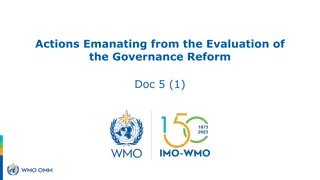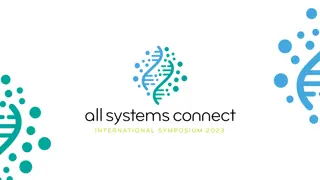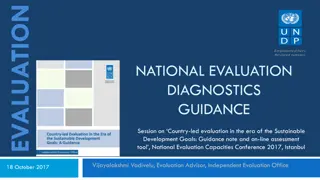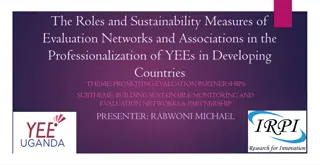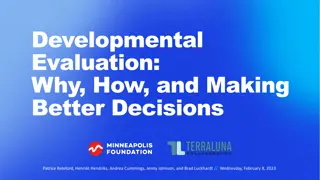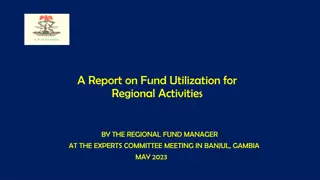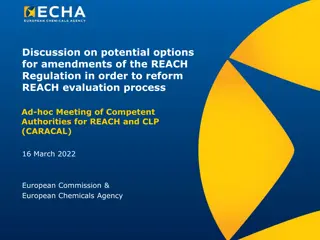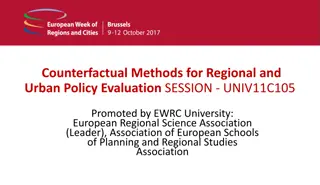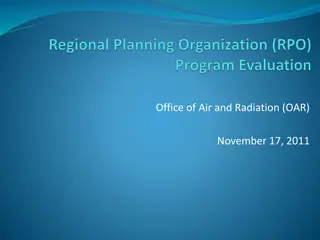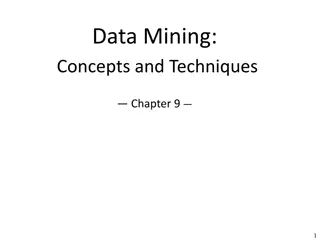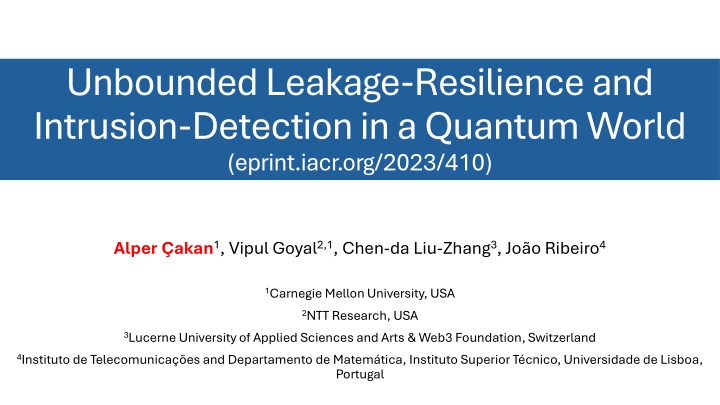
Strengthening UN Regional Evaluation Networks
Opportunities and challenges faced by the UN Evaluation Development Group for Asia and the Pacific (UNEDAP), the UN Network for Evaluation in Sub-Saharan Africa (UNNESSA), and the UN Network for Evaluation in Latin America and the Caribbean (UNELAC) in enhancing the decentralized evaluation function. Learn about their missions, memberships, and key initiatives to promote evaluation culture and coherence within the UN system.
Download Presentation

Please find below an Image/Link to download the presentation.
The content on the website is provided AS IS for your information and personal use only. It may not be sold, licensed, or shared on other websites without obtaining consent from the author. If you encounter any issues during the download, it is possible that the publisher has removed the file from their server.
You are allowed to download the files provided on this website for personal or commercial use, subject to the condition that they are used lawfully. All files are the property of their respective owners.
The content on the website is provided AS IS for your information and personal use only. It may not be sold, licensed, or shared on other websites without obtaining consent from the author.
E N D
Presentation Transcript
Unbounded Leakage-Resilience and Intrusion-Detection in a Quantum World (eprint.iacr.org/2023/410) Alper akan1, Vipul Goyal2,1, Chen-da Liu-Zhang3, Jo o Ribeiro4 1Carnegie Mellon University, USA 2NTT Research, USA 3Lucerne University of Applied Sciences and Arts & Web3 Foundation, Switzerland 4Instituto de Telecomunica esand Departamento de Matem tica, Instituto Superior T cnico, Universidadede Lisboa, Portugal
Age-Old Problem: Storing Secrets Most cryptography assumes attacks through well-defined channels: Encryption Adversary sees ciphertexts and public-key Signatures Adversary sees signatures and verification key Pseudorandom function Adversary sees evaluations No information about secret keys! Real-life attacks do not conform to this: Side-channel attacks
Side-Channel Attacks Adversary can learn partial information about secret keys through various methods: Timing attacks [Kocher96]: broke every smartcard in the world! Remote timing attacks [BB03] Power Analysis attacks Electromagnetic radiation analysis Thermal imaging attacks How to keep secret keys secure?
Leakage-Resilient Cryptography Try and design schemes secure against side-channel attacks Very successful line of research [ISW03, MR03, AGV09, ] But how to model the side-channel attacks? Most commonly used model: bounded leakage Adversary learns function of its choice to secret key Usual security (e.g. semantic sec., unforgeability etc) must still apply as long as the leakage function has bounded output length Why bounded length? Because otherwise it is impossible to achieve security!
Our Results Quantum information is fundamentally better for storing secrets! Also: a brand new application of no-cloning! More precisely, we design schemes (in plain model) for primitives such as Public-key encryption Signatures Pseudorandom functions and more where secret keys are stored as quantum states, and they can tolerate arbitrary unbounded leakage! No unjustified bounds. Everything other than keys are still classical.
Unbounded Leakage-Resilience | ???????(??) For all ? with overwhelming probability | Correctness: m ???( ,???(?)) Implication: Can repeatedly use the state for various ciphertext (Gentle Measurement [Aar 16])
LOCC Leakage-Resilience (LOCC LR) Security ?1 (1) | ?? ???????(??)| (?) | . . . Similar for other primitives: 1. Obtain LOCC leakage 2. Participate in usual security game ??,?? ?????(1?) ?1 ?? ?? ?1 ? =?? ???(??) At most +negl prob. ? Arbitrary leakage functions: No bounds in particular, leakage can be much longer than size of the key itself! ?
Our Model Classical leakage justified? Leakage obtained through side-channel Adversary has no direct access to system Most naturally modelled as observations/measurements: classical information Readily captures all existing attacks! What if the adversary directly breaks into the system? Impossible to achieve anything in a classical world Also cannot be secure quantumly: The adversary can simply steal the key But we can at least detect it!: Intrusion-detection security We obtain schemes for FE, signatures, diO, various classes of functions
Copy-Protection Security ???(??1) | 1 ?1 | ???????(??) At most +negl prob. ?1=??1 ?2=??2 ???(??2) ? | 2 ??,?? ?????(1?) ?2
Copy-Protection Leakage-resilience? Classical info. easily copiable If leakage allows decryption, leak and copy the leakage Reduction from leakage-resilience to copy-protection? Already long line of work on copy-protection, can get LOCC LR automatically Challenges: Adversary internal state: Final state depends on leakage circuit choices. State is quantum, cannot be cloned to get 2 pirates. 1 adversary vs 2 adversaries: If one LR adversary succeeds with probability +1/p, two pirates will succeed with probability + 1/p
Copy-Protection Leakage-resilience? Leak-and-copy is not the only reduction Can there be smarter reductions? No, we show: Relative to unitary quantum oracle, there exists a scheme that satisfies copy-protection but not LOCC LR In fact, it does not even satisfy 1-round adaptive leakage-resilience!
Coset States [CLLZ21, VZ21] 1 ? = 1 ?, ? |? + ? where random ? ?2 ?,dim ? = ?/2 ?,? ?2 |?? ? 4 2 ? ? ? ?1? = 1 iff ? ? + ? ?0? = 1 iff ? ? + ? Properties: Can efficiently generate the states Canonical element of Can be computed efficiently using ? ?|?? ? = |(? )? ? ? + ?: ????(?) ?
Monogamy-of-Entanglement [CLLZ21, CV22] ? | 1 ? ? |?? ?? ?0, ??(?1) At most negl. prob. ? ?? + ? ? ?? + ? ? | 2 Sample ?,?,? ? ?
Result: LOCC Leakage-Resilience for Coset States ?1 (1) | ?? (?) | . . . |??,??,?? ? [?] Sample(??,??,?? ) ?1 ?? ?? ?1 ?,?? ?1 ? ?? ?0 ? {0,1}? ?? ???+ ?? if ??= 0 ?? ?(??) + ?? ? [?] At most negl prob. ?? ? [?] if ??= 1 ?
Proving the Property Monogamy-of-entanglement (MoE) Copy-protection flavor LOCC LR property Leakage-resilience flavor Same problems as before persist Solution: 1) Move to information-theoretic setting Use subspace-hiding obfuscation [Zhandry 19] to remove membership programs Now will reduce to info. theoretic MoE 2) Previous issues? Force a collision in leakage circuit choices by repeatedly running multiple simulations Same leakage circuit: Leak once, reply to both copies We show that exponential time is sufficient, which is fine info theoretic setting
Construction Encryption )? [?] ?? = (??,??,?? 1) Sample ? 2) Output ?,??(???) ???????(??) |??,??,?? ???(?1, ,??) ?,?1 ?)? [?] ?? = (?0 ?,?1 ?)? [?] x Hardcoded: m, ?,(?0 1) For ? [?] check if ?? 2) Output ? if checks pass ??? = 1 Same as copy-protected PKE construction of CLLZ 21 Needs new proof and the LOCC LR property for coset states: Cannot be LOCC LR for free due to barriers discussed
Proving Security Intuitively: Decrypting requires vectors in correct cosets wrt to r LOCC LR property for coset states: Requires vectors in correct cosets wrt to r If we had black-box obfuscation: Reduce to LOCC LR property by simulating the leakage phase, then extracting the vectors Plain model solution: Use compute-and-compare obfuscation [WZ 17]
Intrusion Detection What if the adversary completely breaks into the system rather than obtaining side-channel information? It can obtain quantum information and also cover its tracks by modifying states Cannot have resilience security: Adversary can simply obtain the keys But we can have detection security: Intrusion detection security: Adversary applies arbitrary quantum circuit to key. Challenger runs TestIntrusion, if it outputs 1, adversary loses (intrusion caught). If it outputs 0, adversary cannot decrypt ciphertext etc with non-trivial probability. We prove equivalence to certified deletion with public testing
Results Intrusion-detection results: Assuming iO and OWF, there exists {functional encryption, signature scheme, differing-inputs obfuscation, software protection scheme} with intrusion- detection Summary of our leakage-resilience results: Assuming subexp. secure iO and LWE, there exists {public-key encryption, signature, PRF} schemes with LOCC leakage-resilience. Any secret sharing scheme can be (information-theoretically) compiled into a scheme with unbounded leakage-resilience for the same access structure Assuming OWF, there exists SKE with unbounded leakage-resilience Copy-protection does not imply LOCC leakage-resilience.
Eprint 2023/410 Questions?

